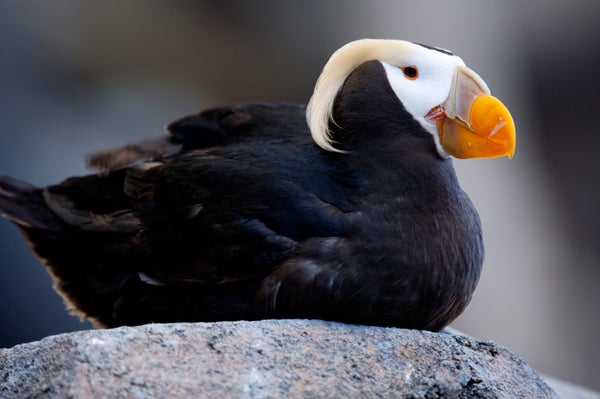In October 2016, a tiny island in the frigid waters between Russia and Alaska was the site of a morbid mystery. Dozens of dead seabirds began suddenly washing up on the shore. The bodies continued to arrive for months.
It was a jolt to the local residents of St. Paul Island, northernmost of a group of four volcanic formations known as the Pribilof Islands, clustered in the icy Bering Sea. While dead animals might occasionally wash up under normal circumstances, the daily bombardments of sodden carcasses were clearly the mark of a mass die-off. More remarkably, most of the birds were tufted puffins, a species that rarely washes up dead on the island at all.
Perhaps most disturbingly of all were the birds’ emaciated bodies; they likely starved to death.
On supporting science journalism
If you're enjoying this article, consider supporting our award-winning journalism by subscribing. By purchasing a subscription you are helping to ensure the future of impactful stories about the discoveries and ideas shaping our world today.
Shortly after the bodies began to appear, scientists started speculating that the die-off might be linked to climate change. Now, new research published this week in the journal PLOS ONE reiterates this theory—and suggests the event may have killed thousands of puffins across the Bering Sea.
Led by Timothy Jones of the University of Washington, the researchers used special models to simulate the way winds and waves carry objects through the Bering Sea and deposit them on the shore of St. Paul. These simulations helped highlight the number of carcasses that were actually found washed up on the beach, versus the number that were swept back out to sea before they could be counted—and the number that never made it onto shore at all.
More than 300 carcasses were recovered on the shoreline. Using their simulations, however, the researchers estimate that anywhere from 3,150 to 8,800 birds likely died in the event. Most of them were probably puffins.
Analyses on a handful of the bodies found that toxins, often the suspected culprit in mass animal die-offs, were not to blame. Instead, it appeared most of the birds starved to death. Many of them were molting, the researchers note—an energy-intensive process that can make birds more vulnerable to stressors like food shortages.
The food stress itself is likely being driven by changes in the Arctic related to global warming, scientists say.
In their new paper, Jones and his colleagues point out that climate-driven changes in the Bering Sea, from rising water temperature to vanishing sea ice, are affecting the abundance and distribution of fish and other marine organisms. Those are important food sources for puffins and other seabirds. They suggest these changes triggered the 2016 die-off.
The Arctic as a whole is one of the most rapidly changing regions of the Earth. It’s warming about twice as fast as the rest of the planet on average. And the Bering Sea, in particular, is undergoing one of the most noticeable transformations. Over the last few years, water temperatures have been higher than usual and its sea ice cover has declined dramatically—even in winter, when the ice should be at its greatest extent.
That decline is already having a significant effect on the Bering Sea ecosystem, according to Robert Foy, director of NOAA’s Alaska Fisheries Science Center, who commented on the study for E&E News. There are fewer fish than there used to be, and many of the fish that remain are in poorer condition, with lower fat content, making them less nutritious for the bigger animals that eat them.
“We have found substantial movement patterns in some of the pollock and cod stocks from the southeastern Bering Sea to the northeastern Bering Sea, where upwards of 50% of the cod stock may have shifted distribution towards the north,” he said.
In general, Foy said, it’s “very plausible” that changing conditions in the Bering Sea are to blame for the 2016 mass mortality event. And it’s probably not the only die-off linked to recent climate change in the Arctic and the northern Pacific.
During the winter of 2014 through 2015, for instance, thousands of Cassin’s auklets washed up dead on the shores from California up to British Columbia. Scientists also believe that starvation, linked to warm ocean temperatures and a recent change in prey availability, was to blame. Between 2015 and 2018, scientists also recorded several seabird die-off events, affecting multiple species, in the Gulf of Alaska and the Chukchi and Bering seas.
Puffins, in particular, have begun to garner increasing concern, and not only off the coast of Alaska. The New York Times reported in 2018 that puffin colonies in Iceland and other parts of the North Atlantic also seem to be suffering recent declines linked to food shortages, and scientists are working to determine how much of it is linked to the impact of climate change.
In the Bering Sea, the most dramatic trends have occurred within the last five years or so, meaning “the question remains what will happen if that colder water returns in future years,” Foy noted.
But in the long term, models project a continued increase in water temperatures and marine heat waves, as well as continued declines in Arctic sea ice. And there’s concern that as Arctic ecosystems continue to adjust, seabirds and other animals may become more vulnerable.
“Experts around the world expect that we will see more events such as these heat wave events,” Foy noted. “And the likely effect is, as the authors [of the new study] state, the potential for these large scale die-offs.”
Reprinted from Climatewire with permission from E&E News. E&E provides daily coverage of essential energy and environmental news atwww.eenews.net.
